Blackpool, UK, October 18th - 24th 1909
Almost the first air race meeting in the UK...
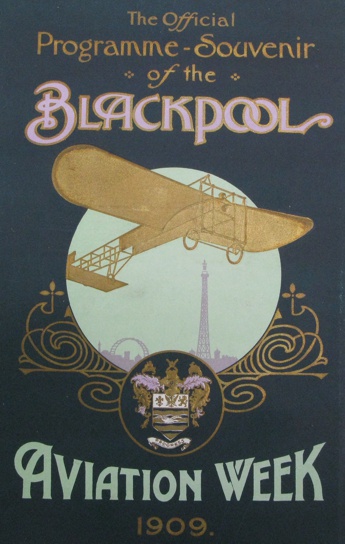
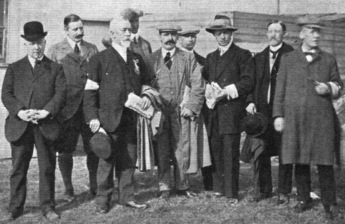
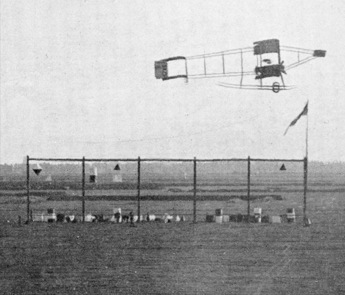
White/black double cone: the Daily Sketch prize for speed White/black cylinder: GP of Blackpool for long distance
Black cone, white cylinder: Rougier
Black cone: (incomplete) wind speed indication (2)
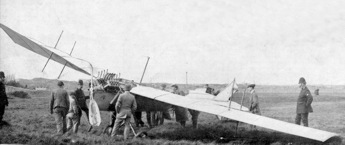
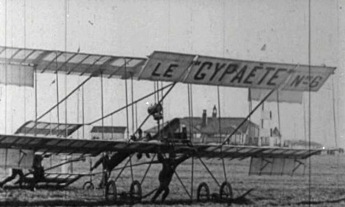
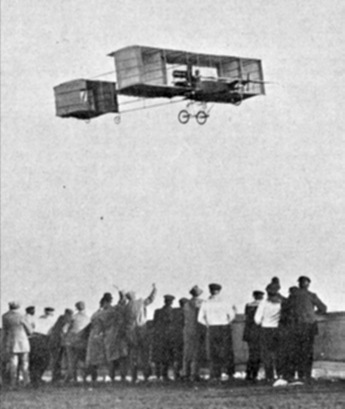
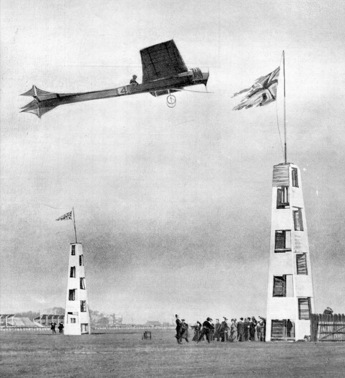

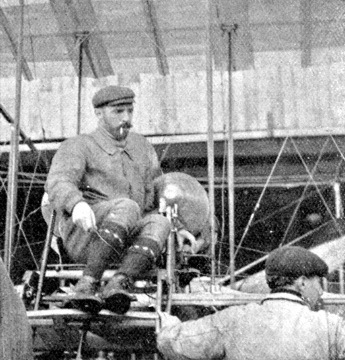
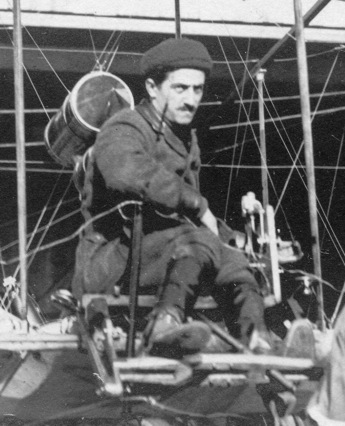
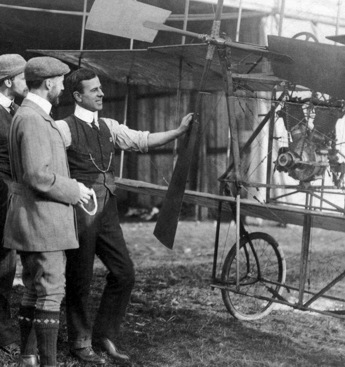
Blackpool, "Mecca of the Lancashire holiday makers"
according to "Flight" magazine, was the biggest resort in
north-western England. Among the attractions were eleven kilometres of
sandy beaches, the promenade with its piers and amusements, three
theatres, an aquarium, the Winter Garden entertainment complex and the
158 metre Blackpool Tower, modelled on the Eiffel Tower. In 1909 the
town's population was around 50,000, but the number of visitors was
estimated at three millions per year.
It was natural for the leading people of such an enterprising town to
look for new attractions, and what could be more natural than an
aviation meeting. A delegation from the town, including the Mayor,
visited the "Grande Semaine d'Aviation" of Reims in
August 1909 and in the beginning of September it was decided to go
ahead with the planning.
A prize fund of over £6,000 was quickly raised, the main contributors
being the Blackpool Corporation (which ran the trams and other
services), Lord Northcliffe and Sir Thomas Lipton. The owners of the
Blackpool Tower offered a prize of £500 for a flight round the tower,
which was turned down on safety grounds. In order not to frighten
visitors away by overcharging, the Blackpool Corporation agreed with
the hotels and boarding-houses in the town that their charges during
the week should not be more than five per cent higher the usual rates.
The Lancashire Aero Club was formed and arranged the lease of the
airfield, which was situated on a golf course some three kilometres
south of Blackpool, and built a clubhouse, hangars and repair shops.
Their ambition was to "create an English edition of Port
Aviation". The famous French pilots Henry Farman, Louis Paulhan,
Hubert Latham, Henri Rougier and Alfred Leblanc were engaged, no doubt
attracted by the appearance money, which was generous, although not as
high as at the Doncaster meeting. Some less known British flyers were
also entered, as was the France-based Spaniard Antonio Fernandez in a
plane of his own design. Preparations apparently ran smoothly and the
installations were ready for the opening day.
Monday 18 October
The weather on the opening day was perfect, with sunshine and only a
light breeze greeting the 60,000 spectators. The first pilot to make an
effort, shortly after noon, was A. V. Roe in his triplane. He had lots
of problems getting his JAP V-twin engine started. When it finally ran,
a bracing wire came loose after a long ground run in the underpowered
plane and it had to be hauled back to its hangar for repairs. Soon
afterwards Farman made the first successful flight, completing a test
hop and then a lap in Paulhan's new "Gypaète". They
shared Paulhan's plane during the meeting, since Farman's own
was reported to be held up somewhere on the French railways. Then
Paulhan took over the plane and flew another lap. At 15:20 Farman
returned and took to the air in order to go for the "Daily
Sketch" three-lap speed prize. He flew seven laps in just under 23
minutes, the last lap at a speed of 59.98 km/h. His speed over the best
three laps was 58.54 km/h (36.38 mph). While he was flying Rougier made
a test flight. After landing to repair his rudder he then took off for
what turned out to be the day's longest flight. He covered nine
laps in his slower Voisin, totalling 28.8 km in 34 minutes. Towards the
end of his flight Paulhan started for a six-lap flight, but he
couldn't beat Farman's times, his best lap being 54.37 km/h
(33.79 mph). Leblanc flew a single lap in his Blériot, as required by
his contract. This was his only flight during the meeting, and it
didn't count for any of the events, since he didn't pass the
start line correctly. The last flight of the day was made by Farman,
with Paulhan as passenger.
Tuesday 19 October
The day started a little windier than the day before, and the wind from
the sea got stronger and gustier during the day. Farman and Paulhan
were busy fitting a larger fuel tank, so Latham was the first to make a
flight, at around 12:15. He had covered less than half a lap when his
front skid hit a mound. The tail flipped high in the air after the
impact, but Latham managed to hang on to his seat. The rough landing
resulted in a ripped-off skid, a broken wheel and a bent propeller. Roe
made a new effort, with slightly better results, but he only managed
two short jumps. Towards the afternoon Paulhan flew eight laps,
staggering and lurching in the gusts, but due to the stronger wind, by
now some 7 m/s, he could not improve on the times of the day before.
Rougier had also brought out his plane, but decided against flying in
the strong wind. Fernandez also brought his plane out, but didn't
manage to leave the ground.
By four o'clock increasing winds and a heavy rain shower forced the
black flag to be flown, signalling the end of a disappointing day for
the 30,000 spectators. On the Tuesday it was announced that the FAI had
decided that course lengths should be measured from pylon to pylon,
along the inner line of the course. This meant that the distances and
speeds, which had previously been based on the distance along the
middle of the course, had to be recalculated. The new course length was
given as 3.197 km (3496 yards).
Wednesday 20 October
After a very rainy night the morning broke fine and the wind was not
too bad. Singer brought out his new Voisin, but the tail was rigged
with too much incidence and repeatedly made the nose hit the ground. A
Blériot recently bought by the Blackpool Councillor Mr A. Parkinson was
also briefly tested on the ground. Fernandez brought out his plane at
around 10, but only made an unsuccessful attempt, after noon. Farman
brought the "Gypaète" out at around one o'clock and
immediately started to fly like clockwork, with almost identical lap
times and at constant minimum altitude. While he was flying Paulhan
marked the length of the flight by laying a white handkerchief on the
ground for each fifteen minutes flown. After 1 h 32:16.8 and 24 laps,
and presumably six handkerchiefs, he landed, complaining of cramp and
hunger, having set a new British endurance record. The wind increased
again, forcing Rougier to abandon a flight after only 12 minutes. Then
Paulhan took off, but landed after only one lap to replace an aileron
which had been broken when the plane was caught by gust during the
take-off. After the repairs the wind was again reaching 11-12 m/s in
the gusts and he withdrew to the hangar after half a lap. Latham
brought his repaired Antoinette out, but landed before the first turn.
Roe also made an unsuccessful start in his underpowered triplane and
Fournier's Voisin was seen outside his hangar for the first time.
Soon after four o'clock the black flag was flown again.
Thursday 21 October
In the morning the wind registered 13 m/s, and during the day it
increased to more than 20 m/s in the gusts. Flying was of course
impossible, but the organisers put up fences in front of the hangars
and charged one shilling for access, so the spectators were at least
able to see the machines being worked on at close distance. The
Antoinette crew made a dynamometer test, anchoring the machine to a
post and measuring the thrust, which was found out to be around 1200 N
(265 lbs). During the afternoon L. Lumb from Blackpool and Jack
Humphreys from Wivenhoe brought their respective machines in to be
displayed, but they would take no part in the meeting.
Friday 22 October
The wind had decreased slightly, but it rained and was very humid. The
local shoe shops made good business in selling rubber boots, which were
needed in order to navigate the sodden grounds. Nobody expect any
flying, but those who braved the weather got to see a flight that was
for a long time regarded as one of the most daring of all time. Around
one o'clock, with the wind speed reaching 13 m/s (30 mph) in the
gusts, the red flag was suddenly hoisted and a horse pulled
Latham's Antoinette out on the starting ground. His first effort
failed when the wind caught one of the wings and made the opposite wing
tip touch the ground. The tail flipped high in the air before falling
back again. Undeterred, Latham made a new try, this time with mechanics
holding the plane down until he had it under control. The plane
immediately rose to around 20 meters and after narrowly avoiding a
collision with the first pylon and crossing the wind at the second
pylon he was driven with the wind from behind at a speed which was
speculated to reach at least 100 km/h. After an agonizingly slow flight
against the wind he again had the wind from his side on the front
straight, and spectators and officials screamed to him to come down. He
didn't, but continued and completed on more lap, working the two
control wheels frantically as the plane was thrown this way and that by
the gusts, "tossed around like a cork in a cataract", before
landing safely after a flight of eleven minutes. The other flyers
carried him off to a lunch where Fournier proposed a toast to
Latham's health. He said that Latham's flight was "the
most wonderful ever attempted" and that he was "clearly the
first man in aviation". Latham's first lap of 40.4 km/h won
him the slow flight price. The second lap was even slower, but he was
blown too far off the course, so the time was disallowed. It has been
stated that he made the flight in order to honour a promise made to the
Countess of Torby, wife of Grand Duke Michael of Russia, during a
dinner the night before.
During the afternoon it was announced that the meeting would be
continued on Monday, Tuesday, and Wednesday for the benefit of British
competitors.
Saturday 23 October
The rain continued to fall during Friday night and Saturday morning,
turning the hangar area into a lake. Some hangars could only be reached
by planks. Under those circumstances nobody took the risk of any
flights. During the afternoon the wind increased again. The
international part of the meeting was concluded by a dinner at the
Metropole Hotel, offered by the mayor of Blackpool, where the prize
cheques were handed to the winners. The passenger prize and the
altitude prize were not awarded, and the competitions for British
pilots all fell through since they were intended to start on the
Wednesday and coincided with the arrival of the bad weather. No flying
was planned for the Sunday.
Monday 24 October
The weather didn't improve, so at ten o'clock the committee
decided to call off the rest of the meeting. Soon afterwards the wind
decreased slightly, but the field was still very wet. During the
afternoon some of the British aviators tested their planes. Roe had by
now fitted a 24 horsepower engine to his triplane and was the only one
to leave the ground, but only for 40-50 meters. Creese's plane had
apparently been damaged by water in his hangar and his plane
wouldn't leave the ground. Saunderson and Neale did not manage to
make any flights.
Conclusion
The 1909 Blackpool meeting can hardly be called a success, even though
Farman's and particularly Latham's flights went into the
history books. All in all, only four pilots managed to fly a complete
lap during the meeting, and this includes Leblanc's single flight.
The total distance flown during the meeting was around 186 kilometres.
It was natural to compare the Doncaster and Blackpool meetings. It
appears naïve to organise anything that requires good weather in
England in the end of October, and attendance at both meetings was
badly hit by the rain and wind. The controversy and competition between
the meetings certainly harmed both. Painful as it must have been for
the Royal Aero Club, it appears that the Doncaster meeting was more
popular with the spectators. It was held at a pre-existing horse race
course where infrastructure such as restaurants was already at hand.
The Blackpool airfield with its temporary installations was in an
exposed position, only a couple of hundred meters from the windy Irish
sea, and the proximity of the holiday centre of Blackpool with its
hotels, restaurants and nightlife, and trams running to the airfield
gates, could not compensate for this disadvantage. Blackpool was also
criticised for the high number of policemen and for the attitude of the
officials. The British aviator John Neale wrote a very critical letter
to the "Daily Mail" about the leaky hangars and the way the
British flyers were treated by the organisers.
The Blackpool meeting also lost money, but not as much as the Doncaster
meeting. The appearance money paid to the pilots was considerably
lower, £ 4,200 compared to £ 11,600, which certainly helped.
